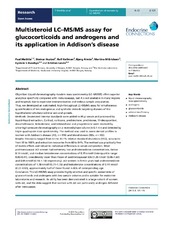| dc.description.abstract | Objective: Liquid chromatography–tandem mass spectrometry (LC–MS/MS) offers superior analytical specificity compared with immunoassays, but it is not available in many regions and hospitals due to expensive instrumentation and tedious sample preparation. Thus, we developed an automated, high-throughput LC–MS/MS assay for simultaneous quantification of ten endogenous and synthetic steroids targeting diseases of the hypothalamic–pituitary–adrenal axis and gonads. Methods: Deuterated internal standards were added to 85 μl serum and processed by liquid–liquid extraction. Cortisol, cortisone, prednisolone, prednisone, 11-deoxycortisol, dexamethasone, testosterone, androstenedione and progesterone were resolved by ultra-high-pressure chromatography on a reversed-phase column in 6.1 min and detected by triple-quadrupole mass spectrometry. The method was used to assess steroid profiles in women with Addison's disease (AD, n=156) and blood donors (BDs, n=102). Results: Precisions ranged from 4.5 to 10.1% relative standard deviations (RSD), accuracies from 95 to 108% and extraction recoveries from 60 to 84%. The method was practically free of matrix effects and robust to individual differences in serum composition. Most postmenopausal AD women had extremely low androstenedione concentrations, below 0.14 nmol/l, and median testosterone concentrations of 0.15 nmol/l (interquartile range 0.00–0.41), considerably lower than those of postmenopausal BDs (1.28 nmol/l (0.96–1.64) and 0.65 nmol/l (0.56–1.10) respectively). AD women in fertile years had androstenedione concentrations of 1.18 nmol/l (0.71–1.76) and testosterone concentrations of 0.44 nmol/l (0.22–0.63), approximately half of those found in BDs of corresponding age. Conclusion: This LC–MS/MS assay provides highly sensitive and specific assessments of glucocorticoids and androgens with low sample volumes and is suitable for endocrine laboratories and research. Its utility has been demonstrated in a large cohort of women with AD, and the data suggest that women with AD are particularly androgen deficient after menopause. | en_US |

